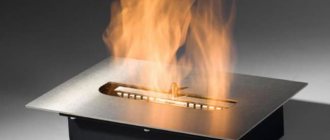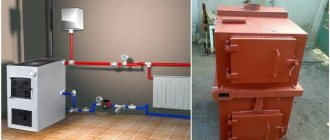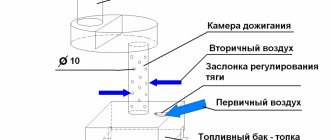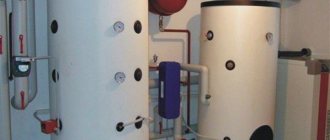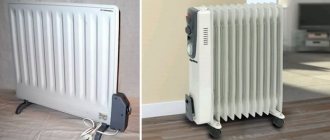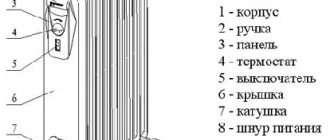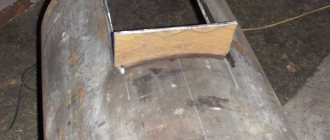Idea N3: Oil heater
Since technical oil has good heat transfer functions, it is widely used in heaters.
You can assemble this oil heater yourself at home. To do this, you will need an old heating radiator (cast iron or bimetallic battery, register or other tubular structure), a tubular heating element, the oil itself as a coolant, sealed plugs for placing the heating element. Rice. 11: Example of using a register control unit
To maximize the safety of the oil device, it can be supplemented with a heating sensor, the open contacts of which are connected to the power circuit.
The manufacturing process of an oil cooler is as follows:
Take the old radiator, it is important that it is replaced due to the modernization of the system, and not due to a violation of the integrity of the case. It is advisable to verify this yourself by adding liquid or at least through an external inspection
Rice. 12: Take an old radiator
Prepare two holes in the heater - for the heating element and for filling the oil. The first hole must be equipped with a thread and located in the lower part so that the heated masses rise upward. It is more convenient to place the second hole in the upper part; when putting the heater into operation, it will also have to be sealed. In addition, holes can be made for draining the oil and for the emergency pressure relief valve. Rice. 13. Prepare two holes
Screw the heating element into the hole on the radiator. When choosing a specific heating element model, it is important to make sure that the thread diameter matches the hole diameter, and that the kit includes oil-resistant rubber gaskets. Rice. 14: screw the heating element into the bottom hole
Another important point is that the diameter of the heating element must be such that it never touches the walls of the radiator. For sealing, linings, special compounds and tow are used.
- If you left necks for oil drainage and for installing sensors, install the appropriate equipment in them. Seal all holes that will not be used in the future, leaving only the neck for filling the oil.
- Fill the heater with technical oil approximately 85% of the total volume.
A margin of 15% is necessary for the free space that the liquid will occupy after heating and thermal expansion. Never fill oil too close. Close the oil filler neck. Rice. 15: Close the oil filler neck - Ground the heater to a ground loop.
It should be noted that to increase the service life of such a device, the heating element should be selected in accordance with the housing material. Otherwise, due to the large difference in the output voltage of the particles of these metals, destruction of the elements will occur. Also note that the heater will have a decent weight, so it is advisable to ensure it is securely fixed in space or make a structure for ease of movement.
Rice. 16: Wheeled design
Oil device
A homemade oil heater is a fairly functional and safe device. It has high efficiency and is therefore suitable for those rooms where various household appliances are repaired.
Its design consists of a sealed housing, inside of which there is oil and heating elements.
Before making a heater with your own hands, you need to prepare the following materials:
- Sealed container. You can use an aluminum or metal battery or a car radiator as it.
- Technical or transformer oil.
- Heating element 4 pcs.
- Electric motor with a power of 2-2.5 kW. Instead, you can use a pump with the same power.
- Switch.
- Set of drills.
- Corners or profile pipe with dimensions 40x40 mm.
- Two tubes. Must withstand temperatures of 100-150 °C.
You will have to work with a drill and a welding machine.
Algorithm for manufacturing an oil heater
- Frame welding. Before this, draw a diagram of the frame. To do this, you should start from the size of the selected container and the height at which the case should be placed. The frame can be made in the form of two rectangles. The width of the rectangle should be greater than the depth of the selected container, and the length should be greater than the height of the container. The main part will be inserted into rectangles. These parts of the frame should be at the ends of the container. Each rectangle must have two legs. It is advisable to connect them with one corner, which will run along the body.
- Cutting 7 holes in the selected container. 4 of them must be such that a heating element can fit in one hole. They can be located in the corners of the radiator. 2 holes are needed for the pump. They are made at the bottom of the radiator. Another hole is needed to fill the oil. It needs to be done at the highest point of the radiator. You can use a grinder or welding to cut holes. The best option is autogen.
- Making a mount for fixing the pump. To do this, metal plates with holes cut in them for bolts are welded to the container. These plates should be located close to the pump holes.
- Fixing the pump and connecting it to the radiator. To connect it you need to use two tubes. They can be welded to the radiator and connected through shut-off valves to the pump. You can weld fittings to the holes intended for the pump and attach tubes to them.
- Mounting heating elements. They are secured using bolted connections. The easiest way to mount those heating elements is the base of which has a thread and is a kind of large bolt. In this case, a fitting with internal thread is welded to the holes in the radiator. A nut may also work. A heating element is screwed into it.
- A fitting with an external thread is placed and welded onto the oil filling hole. There will be a lid on it. It can be made from a pipe. To do this, an internal thread is cut at one end. It should be the same as the thread on the fitting. The pipe must have a larger diameter than the fitting. A metal square plug is welded to the second end.
- Check the tightness of all holes. To do this, create a lot of pressure in the middle of the oil heater.
- Heating elements are connected. To do this, use the parallel connection method.
- Connect the voltage regulator and cable with plug.
- Place the housing on the frame and ground it.
- Pour oil.
The oil heater is now ready and can be used. Over time, it may fail and require repair. Repair comes down to replacing heating elements or pumps. Sometimes it may be necessary to improve the tightness of connections. This type of repair is not very difficult.
DIY 12 volt heater (24 photos)
Instructions for making a battery disconnect switch with your own hands
How to make a 12 volt heater with your own hands: detailed photo instructions.
This simple heater works on the principle of a heat gun; a fan drives air onto a heated coil, resulting in a flow of warm air. The device operates from a 12 V power source; it can be connected to the car’s on-board power supply or to a 12 V battery.
To make a homemade product you will need materials:
- Can.
- Cooler with grill from a 12 V computer.
- Nichrome wire.
- Gypsum.
- Syringe.
- Wires.
- Switch.
- A piece of steel wire.
The entire process of making a homemade heater is shown in these photos.
As a heating element, the author used a piece of nichrome wire 1.8 mm thick, 61 cm long. The wire needs to be wound in the form of a spiral; here the author wound the wire on a 30 cc medical syringe.
Now you need to make a base on which the spiral will rest; it is made of plaster. The gypsum is mixed with water until it reaches a liquid consistency; we collect the liquid gypsum into a syringe.
After half an hour, the plaster will harden and can be removed by cutting the syringe in half.
We will make a body from a tin can.
We install a fan grill on the can.
We attach the fan to the back cover.
We paint the body.
We remove the frozen plaster from the syringe.
At the ends of the gypsum blank we make holes for attaching to the can body.
We put on a nichrome spiral.
We fasten it.
We connect the switch and wires.
Here is a diagram for connecting the coil and fan for the heater.
We bend the legs for the heater from steel wire.
The author measured the temperature of a working heater.
You can make such a homemade 12-volt heater with your own hands from scrap materials.
samodelki-n.ru
Do-it-yourself primitive heating of the interior of any car in winter: current technologies
Fan heater
Those who like simple solutions will like additional means of heating the interior. Designing a car heater from a cigarette lighter with your own hands is one of the simple and affordable options for designing additional heating. The advantages of such a device are difficult to underestimate:
- Fuel and oxygen are not burned.
- Possibility of use in cars of any class.
- Compact design.
A similar solution is commercially available. Its name is a 12 Volt car fan heater. The main disadvantage is low efficiency: it cannot create a microclimate alone. It is recommended to use the car heater only as an addition to standard heating devices. Yours is more reliable and, moreover, repairable - all by analogy with winter washers: a homemade anti-freeze recipe is much better than a roadside canister of an unknown potion.
Ceramic oven
Using combustion gas as a heat source is an effective way to quickly raise the temperature to comfortable levels. The minimum elements are a ceramic stove and a 15-liter gas cylinder. The risk of fire and intense oxygen combustion limit the demand for this type of heating.
Modify the factory furnace
It is preferable to take the path of improving standard equipment, but the costs are incomparable. Modifying a heater is not an easy task: it requires skill and the elements are compact in size. It is not a fact that an additionally installed radiator will have an effect, since it is difficult for the fluid to warm up to operating temperature. Another thing is to introduce an electric heater from a diesel modification (RTS) - the effect is obvious. In addition, warm air flows immediately after starting the engine.
Autonomous heating device
DIY boat trailer. manufacturing instructions, drawings, materials
This heater is designed for 12 volt current. Thanks to this, it can be connected to a battery. It can be used in rooms where there is no heating and where renovations are being carried out, as well as in the garage or any room in the house. Its power is not enough to heat the entire room. It does not create infrared rays. It only heats the air.
To make it you need to take:
- Metal can. It could be a coffee can. Its height and diameter should be 20 and 10 cm, respectively. These values may deviate upward or downward. You should not use a jar made of plastic, cardboard or any other material. This is because they are poor conductors of heat.
- Bracket. It can be a U-shaped part of a children's metal construction set.
- Bayonet cartridge.
- Car brake light lamp. It is designed for 12 volts. Its power is 25 W.
- 2 A fuse.
- Sleeve made of insulating material.
- Cable. The cross-sectional area of one wire must exceed 1 mm².
Sequence of manufacturing an autonomous heater
A 12 volt device is made as follows:
- Drill 20-30 holes in the side wall of the can. Their diameter should be 3 mm.
- Make a hole in the bottom of the jar. It is drilled in the center of the bottom. The diameter should be equal to the diameter of the bolt that will secure the bracket.
- Fix the bracket at the bottom of the can.
- A cartridge is secured to the top of the bracket. This element must be positioned so that the lamp does not touch the walls of the container.
- A hole is drilled in the side wall of the can at the level of the top of the bracket so that the bushing for the cable fits in it.
- A sleeve is inserted into this hole and an electrical wire is pushed through it, through which a current of 12 volts will flow. The cable will be connected to the socket.
- Screw in the lamp and close the jar with a lid.
- A fuse is connected to the cable break.
The 12 volt heater is ready. Now all you have to do is connect it to the battery and wait 10 minutes. During this time, the homemade garage heater will warm up. When using a device with an operating voltage of 12 volts, you need to monitor the battery voltage. It should not fall below 10 volts. Otherwise, the current source cannot be restored.
Connection
According to preliminary data, each heater circuit will have a load of about 20 A. The first circuit allows you to connect the air heater not through the computer, but directly through a latching button and relay. The control wire to the relay can be taken from the fan. That is, to turn on the electric heater you will need to press a button and turn on the fan. Shutdown is controlled manually!
It should be understood that when all three circuits are turned on, such an electric hair dryer will consume a large amount of current, which is not so much at idle, and even more so in cold weather. Therefore, adding intermediate power levels may be considered. If you use two buttons in the circuit, then the first will include 2 circuits, and the second will include a third. And if the control signal is taken from the glass heating, then there will be a shutdown timer.
Autonomous devices
SITITEK Termolux-200 USB – 4-in-1 battery model
DIY subwoofer: instructions and video
A small interior heater, powered by a battery, can, if desired, be connected to a 12 V car network - a meter-long cord with a plug for the cigarette lighter is included. On the body there was a place not only for the deflector grilles, but also for a small LCD screen, as well as LED indicators notifying about the operating mode of the device. When heating, it blows out warm air with a temperature of +37 °C.
Pros:
- Does not burn oxygen in the cabin;
- There is a timer and clock that allows you to program the heater to start automatically;
- Presence of a 15-amp fuse on the power cord;
- Can be used in summer as a fan to cool the air in the cabin;
- You can charge your phone or tablet via a 500 mAh USB connector;
- Built-in LED light;
- A wide, comfortable handle for carrying, which is not superfluous for a 3-kilogram bar.
Minuses:
- Not suitable for harsh winters, when the outside temperature drops to -20 degrees;
- It takes a long time to charge - up to 18 hours from the cigarette lighter and 6-8 hours from a household power supply.
TRUMA Vario Heat Eco – efficient gas heater
Quite a serious device designed to warm up the spacious interiors of passenger and truck cars, caravans and motorhomes. The heater operates in two thermal modes: 1.3 and 2.8 kW, and is “powered” by liquefied propane-butane from cylinders with a pressure of 30 mbar (usually through a gas reducer).
Pros:
- Relatively low gas consumption - depending on the selected mode 100-220 g/h;
- Good air flow speed (155 m3/h) is maintained even in the most remote areas of the system;
- Automatic power control taking into account the set temperature;
- There is a night mode, in which the fan becomes almost inaudible;
- Possibility of connecting an extensive air duct system for uniform heating of the entire cabin;
- The set includes a control panel with a large and informative display.
Minuses:
Price 125 thousand rubles.
Option number 1: car heater
Of course, in a working car, a 12-volt electric heater is, to put it mildly, useless. But anything can happen: it happens that the stove refuses to work at the most “appropriate” moment, and the car enthusiast, sitting inside an uninsulated metal box, is left alone with the severe frost. Also, a homemade 12 V heater may be needed if the rear window heating system breaks down.
- computer power supply;
- cooler (small fan): it can be removed from the same power supply;
- soldering iron with everything necessary for soldering;
- the wire;
- fragment of tile;
- M5 bolts with nuts of the same diameter (8 pieces);
- nichrome wire.
If everything is ready, you can start creating a homemade heater.
Case manufacturing
First of all, the computer power supply needs to be disassembled into its components. We carry out the disassembly in full: we remove the electronic board fixed with self-tapping screws, the cooler, as well as connectors and switches (during the operation of the heater, they can become a source of an unpleasant odor).
Did you know that a candle flame can be used to heat a room? Let's consider the principle of operation of a candle heater, and also talk about the nuances of its use.
Can using an infrared heater be harmful to health? You will find the answer to this question below.
Wondering what is better: a convector or an oil heater? Here https://microklimat.pro/otopitelnoe-oborudovanie/obogrevateli/chto-luchshe-konvektor-ili-maslyanyj-obogrevatel.html the comparative characteristics of these devices according to various parameters are given.
Manufacturing of heating elements
To make a heating element, you don’t need to “reinvent the wheel”: for this purpose we will use a nichrome spiral - the same as that installed in any heating element. Nichrome (an alloy of nickel and chromium) is a conductor, but it also has significant electrical resistance, so it gets very hot when an electric current is passed through it.
Spirals are made by winding nichrome wire onto any cylindrical rod.
It is important to select the resistance of the heating elements and their connection diagram (in parallel or in series) so that the heater does not overload the on-board electrical network.
Otherwise, the operation of the device will be accompanied by all sorts of undesirable phenomena, for example, insufficient battery charging.
As an example, consider a Daewoo Sens car. The electric generator installed in it is designed for a current of 70 A. In such conditions, it is permissible to use an electric heater that consumes a current of 10 - 15 A - such a load for the on-board electrical network will be almost imperceptible.
The finished nichrome spirals need to be screwed to a piece of tile using M5 bolts and the same nuts. The tile will have to be drilled for this.
The tile with heaters must be secured in the housing from the power supply in such a way that the cooler installed in its place blows on it, expelling warm air into the car interior. As a result, we will get a 12-volt fan heater.
To prevent the material from crumbling, tape or adhesive tape should be placed on it at the drilling site, and the drill should rotate at a minimum speed.
Heater assembly
At the assembly stage, the cooler and cover are installed.
After which all wires are connected to the heater.
Their cross-section must correspond to the calculated current strength.
In a copper wire, for every 10 A there should be 1 sq. mm section, in aluminum - 1.25 sq. mm.
Do not confuse the diameter of the core with its cross-sectional area - for small-diameter wires these values are very similar.
You also need to insert a fuse into the device circuit, which is again selected depending on the calculated current strength.
Installation
Despite the modest voltage, the homemade heater consumes an impressive current and heats up quite strongly. To avoid accidents, it must be secured securely so that the device does not accidentally fall while the car is moving.
The best models of heaters from the cigarette lighter
Below are the best heaters that operate from a cigarette lighter. All of them have proven themselves well among drivers and are suitable for almost any car.
Alca 544200
Alca 544200
Price: from 1,200 rubles.
Pros:
- Long lasting ceramic air heater.
- Built-in fuse protecting against overloads.
- Operates in heating and cooling modes.
- Warming up a large area.
Minuses:
Chinese assembly.
150 W fan heater for the interior from a 12 V cigarette lighter. The ceramic heater effectively heats the air, and the fan directs the flow to the appropriate place. The 1.4 m long power cable allows you to install the equipment even next to the rear window.
The power of the equipment is sufficient to heat an area of up to 5 square meters, which means providing comfort in a car of any size. At the same time, the air does not dry out, so there will be no inconvenience for the driver and passengers.
KOTO EFB 220 12V 901
KOTO EFB 220 12V 901
Price: from 1,300 rubles.
Pros:
- High power.
- Possibility of working in two modes.
- Interesting appearance.
- High quality build.
- Convenience of placement.
Minuses:
The installed protection system does not always work correctly.
Electric heater from a well-known company producing heating equipment for cars. It has a ceramic heating element that heats the air without drying it out. The model is capable of functioning in two modes: as a regular fan or as a fan heater.
Due to the convenient rotating base, you can install the device in any convenient place and adjust the direction of the warm air flow according to your preferences. The power of 200 W is enough to defrost frozen windows, as well as for general heating of the interior.
Heat current v12
Heat current v12
Price: from 1,250 rubles.
Pros:
- Convenient installation on the dashboard.
- Operates in heater or fan mode.
- Folding handle.
- Possibility to regulate air flow.
Minuses:
- The housing is sensitive to damage.
- Low power.
A multifunctional device that allows you to simultaneously blow air onto passengers and the windshield. A convenient stand helps regulate the air flow by tilting the structure in one direction or another by 45 degrees.
The folding handle will provide the necessary comfort when heating icy windows and defrosting specific elements. The model operates much faster than a standard stove, without causing fogging of windows during operation. A power of 150 Watts does not allow heating large areas effectively.
AUTOVIRAZH AV161007
AUTOVIRAZH AV161007
Price: from 1,000 rubles.
Pros:
- Multifunctionality.
- The presence of a folding handle.
- Built-in fuse.
Minuses:
Assembly in China may not be of very high quality.
Car ceramic interior heater that can be used both in winter and summer. The 3 in 1 system can be used as a heater, cooling fan or hair dryer.
In the latter case, the folding handle is especially useful, allowing you to comfortably hold the structure while heating the elements of the car. The case is made of durable plastic and copes well with all loads and practically does not change its properties under regular temperature exposure. The device weighs only 0.45 kg and is mounted on a swivel stand.
Autolux HBA 18
Autolux HBA 18
Price: from 6,900 rubles.
Pros:
- Great power.
- Advanced system for adjusting the direction of airflow.
- Long cable for connection.
- Versatility.
Minuses:
Price.
Powerful car interior heater, suitable even for large trucks. The ceramic heating element transfers temperature well to the air and does not dry it out. In addition to the standard connection via the cigarette lighter, it is also possible to provide power directly from the battery.
The 300 W device allows you to quickly warm up the car windows, as well as create the necessary conditions for the driver and passengers. When installing, it is worth considering the weight of the equipment, which here is 1.5 kg.
DIY incandescent light bulb heater
To make the simplest home heater based on conventional incandescent lamps, you need to be able to connect the wires to the sockets and screw the lamps into them.
A simple heater option is an incandescent light bulb heater
Elements for assembly:
- Wooden plank;
- Two wooden blocks;
- Empty metal cans;
- Cartridges;
- Lamps;
- Power wire.
First of all, it is necessary to prepare the surface for mounting the cartridges. To do this, make holes in a board measuring 50 x 5 cm using a screwdriver and a pen of the required diameter. The cartridges must be held tightly.
Next, we connect the cartridges to each other (in series). We connect the power wire to the first cartridge. Once connected, the cartridges can be collected.
Then, to ensure free space under this structure, we screw wooden blocks along the edges to the board with cartridges, which will also serve to ensure stability.
Next, you should take care of the so-called radiators for this heater. The radiators are old cans in which coffee was previously stored. The inner diameter of the cans should be slightly larger than the diameter of the lamps. Due to the short distance, it is necessary to achieve heating of the metal surface of the cans.
To additionally heat a space, for example under a window, several 60-watt lamps will be sufficient.
Since the jar is closed on one side with a lid, you only need to get rid of the metal bottom. This can be done with any available tools. Next, the can is installed on the board, and an incandescent lamp is placed inside it.
After assembling the structure and installing it in the appropriate place, this device is connected to the network. For ease of use, the power cord can be equipped with a switch. Ready!
It is worth noting that using only infrared lamps, it is possible to create an excellent heater for a garage.
Idea N4: Heater with a spiral
The classic version of a spiral-type heater involves connecting heating coils to the network. Heat-resistant dielectrics were used as the basis for installing the spiral in such models. But these are quite simple options, so in this article we will look at the principle of manufacturing a device whose characteristics are not inferior to a gas heater. It uses the same principle as a heat gun, but with less heat output.
To make it, you will need a heating coil, an electric fan, a metal pipe or box for the housing, a dielectric heat-resistant frame, and a power cord. The heater manufacturing process includes the following steps:
Cut the asbestos cement pipe to the required length (in this example it will be used to make the supporting frame). Rice
17: Cut the pipe to the required length
Drill several holes in the pipe from different sides so that you can insert a nichrome spiral into them. Insert a spiral into the holes, in this example they are made in the form of a lattice, but this is not important, it is important that the heating elements have a different angle of inclination. Rice
18: position of the spiral in the pipe
If you are assembling several pieces of spiral, connect them together on the outside of the pipe.
- Place a fan on one side of the pipe to force air flow.
The direction of the blades should ensure the movement of air towards the spirals stretched in the pipe. The distance from the fan to the heating element must ensure safe operation so that the blades do not melt. For additional cooling, the fan and asbestos pipe can be separated in the housing. Rice. 19: separation of fan and pipe with heater - Insulate the electrical connections both from the fan to the power cord and from the nichrome spiral. To insulate the spiral joints, you can use micanite tape, which is wound directly onto the asbestos surface.
- Place the finished heater in the most suitable housing. In this example, to protect against accidental contact with the spiral, an additional grill is installed in front of the pipe.
It should be noted that the fan power should not be too high so that the coils have time to warm up. In practice, you should achieve a blowing effect, and the heating performance can be adjusted by the length of the spiral. It is also advisable to coat the inside of the asbestos pipe with heat-resistant varnish to prevent asbestos particles from entering the air. It would be a good idea to ground the heater body to a ground loop.
During the cold season, the need for heat especially increases. But not every owner has the opportunity to purchase a factory-made heater. There is nothing difficult about assembling a heater with your own hands.
We bring to your attention four options for creating a heating device from improvised means that will perfectly cope with the task assigned to it. We have described in detail the process of making homemade products. Described the principle of operation and features of operation.
We have included diagrams, photo compilations and video instructions for step-by-step guides.
Homemade hair dryer or 12 Volt car heater
Making a 12 V car heater with your own hands is a fairly simple task that does not require special skills or expensive components. The only thing is that it is not always needed for its intended use.
Main components for the heater:
- Power supply from a computer;
- Small fan;
- Tile;
- Bolts and nuts;
- Nichrome wire.
The main part of a car heater is the housing in which all the components of the device are installed. In order to make a case, you need to remove all components from the computer power supply (cooler, board with various circuit elements and wires). It is worth noting that in addition, you need to remove all plastic elements from the block.
Next, to carry out heating, you need to make a heating element from nichrome wire. To do this, take any cylindrical object (pencil or pen) onto which this wire is wound to form a spiral. The use of this type of wire is due to the fact that this alloy has a very high resistance value.
According to the resistance force of the heating element, the connection diagram to the vehicle's electrical network is selected.
Next, we prepare the surface on which the spirals will be located. In ordinary tiles, holes are drilled, to which heating elements are screwed using bolts.
Creating a homemade heater for the garage and other premises
Just as warmth is important for a person, it is important for a car to be within a certain temperature in order to maintain the longest service life. It is important for us that the car is always ready for work, so we need to maintain the correct temperature in the garage so that the car parts do not “freeze” and do not lose their properties
A car is like a family member and it is important to pay special attention to it, since it helps out more than once in life situations. The topic of heating a garage is very relevant among car enthusiasts. Garages do not have a heating system, so car enthusiasts often buy different models of heaters or make a homemade heater
Garages do not have a heating system, so car enthusiasts often buy different models of heaters or make a homemade heater
The topic of heating a garage is very relevant among car enthusiasts. Garages do not have a heating system, so car enthusiasts often buy different models of heaters or make a homemade heater.
Moreover, if purchased equipment can still somehow comply with fire safety, then home-made models do not guarantee this very safety and often it all ends very badly.
Gasoline auxiliary interior heaters
Webasto is a popular brand that offers a wide selection of quality heaters. One of them is Air Top.
The device comes with a control element and an installation kit.
The device is capable of quickly warming up sleeping areas and cabins even in large trucks (including those operating in harsh climates).
The use of ceramic technology minimizes the load on the battery.
Structurally, the device consists of:
- air intake systems;
- control unit;
- built-in temperature sensor;
- air blower motor;
- burners with evaporative gasket;
- heat exchanger;
- switch;
- fuel pump;
- timers and other nodes.
Design and functionality may vary depending on model.
The only thing that remains unchanged is the main fuel for work - gasoline.
Advantages of a gasoline auxiliary heater:
- high water resistance of parts and connections;
- fast air heating even in a large cabin;
- air capture not from the cabin, but from the street;
- low noise level;
- control using an automatic control unit;
- battery life - up to two hours;
- the presence of a temperature controller, alarm function, and so on.
Characteristics of one of the most popular models Air Top 200 ST:
- power - from one to two kilowatts;
- voltage - 12 Volts;
- gasoline consumption - 140-270 grams per hour;
- volume of incoming air - 78 cubic meters. meters;
- total weight - 2.6 kg.
Gasoline heaters are used:
- for heating cargo compartments when transporting certain goods;
- to normalize temperature in passenger transport;
- in construction, loading and road equipment;
- on yachts or ferries.
Description
- PTC 1K0 963 235 F - conventional additional air heater;
- PTC 1K0 963 235 E - “smart” additional air heater.
Using these catalog numbers you can find out the price on exist.ru. Both radiators have a power of about 1 kW. The difference between a “smart” heating element and a simple one is that it is connected to the ECU (electronic engine control unit). This allows you to automatically control its operation, increase or decrease the load depending on conditions. For example, turn on RTS only under conditions when:
- ─ The load on the alternator is less than 60%;
- ─ Ambient temperature or in the intake manifold (when starting the engine) is less than 5°C;
- ─ Engine speed is more than 800 (500) rpm;
- ─ Coolant temperature is less than 70 °C.
- ─ etc.
An electric radiator has three circuits with which you can set the heating power. When only one circuit is connected, the power is minimal, when all three are connected, the power is maximum. During its operation, it is recommended to use the minimum or medium speed of the stove fan, then the heating efficiency will be higher.
How an autonomous heater works and types of stoves
The autonomous heater is installed in the car, and a control panel is installed in the cabin. Air systems help to obtain a stable temperature in the interior of the car without using a standard system. The designs have a power ranging from 1–7 kW/h, which is enough to heat any car.
Fluid units also regulate the temperature of the machine's engine. They are mounted under the hood and connected directly to the fuel line (or an autonomous tank), the cooling system and the general electrical network.
Operating principle of an autonomous heater
The auxiliary heater functions as follows:
- When the engine is running, fuel enters the combustion chamber.
- The fuel burns and produces thermal energy.
- The cooling solution in the heat exchanger gradually warms up.
- The pumping system forces the refrigerant to circulate through the line.
- As soon as a certain temperature is reached, the fan of the standard car heater starts working.
- At this time, heated air enters the cabin.
Underhood autonomous heaters can be liquid or air. In the first case, the energy from fuel combustion heats up the antifreeze passing through the lines, and in the second - the air. Each option has its own specific features that require detailed consideration.
Making a homemade garage heater
Requirements for composing a garage heater
The most important thing is the safety of this device, since it will be located in a closed room and with very flammable devices. At the same time, you will not be able to be nearby all the time.
If at home we somehow control the heat and constantly monitor safety, then we will not be able to constantly monitor the car, so it is very important to choose a truly safe heating device so that our car remains warm and safe. Therefore, it is very important that the homemade heater does not pose a threat of fire or, worse, explosion.
Also, the heater, naturally, does not burn oxygen and does not emit a certain burning smell
Therefore, it is very important that a homemade heater does not pose a threat of fire or, worse, explosion. Also, the heater, naturally, does not burn oxygen and does not emit a certain burning smell
The unit quickly warms up the room and maintains this temperature for a period of time. The device must be portable and not take up much space, but must be very powerful and efficient.
Option number 2: homemade thermal film
Nichrome makes good thermoelements, but what to do if you don’t have this material at hand? It turns out that ordinary soot can replace it.
It is also a high-resistance conductor, but it has an important feature: a significant part of the thermal energy is released by the heated material in the form of infrared radiation.
This means that heaters with a carbon element heat not only the air, but also the user directly who is in the area of infrared radiation. This property made it possible to create thin film heaters based on carbon emitters.
Gas heaters
Gas interior heaters differ from the “competitors” discussed above in their power source. In this case, the devices operate on liquefied gas.
The main advantages of the designs are ease of execution, safety in use, and complete independence from anything. With such a heater you don’t have to worry about the battery draining.
In addition, gas combustion products do not poison passengers, but are discharged into the street, which guarantees safety even for long-term use.
The principle of operation of the device is to circulate air flows in the car. Heat transfer occurs due to natural convection of air in the car.
For more active mixing, an additional low-power fan can be mounted in the cabin.
Gas autonomous heaters do not cause problems during operation; they have no rotating elements, which ensures maximum reliability and safety.
Structurally, the device is a system of coaxial pipes, when each of the subsequent pipes is located inside the other. One pipe carries clean air from the street, and the second pipe removes exhaust gases.
As a result, the air in the cabin is not used or burned out. All that remains is warmth.
The device does not depend on the performance of the car, so even if the engine breaks down or the battery is discharged in winter (even in an open field), you can turn on the device to enjoy the warmth.
The average lifespan of such devices is about 14 years.
Advantages of gas autonomous heaters:
- affordable price due to the lack of electronics in the device;
- the presence of a climate control system, which is found in most modern devices. At the same time, you can always set and maintain the optimal temperature;
- independence from vehicle resources, which guarantees performance in any conditions;
- the ability to power the device from cylinders of various capacities - 12 and 24 liters.
Basic operating rules:
- the heater can be turned on both when parked and while moving;
- to activate the device, just open the tap through which gas is supplied, turn on the device and start it;
- deactivation is carried out by triggering the corresponding toggle switch.
For example, a good option is SELENA PILOT-2 -E1. The heater requires only gas to operate.
Power - about 2 kW, heated area - up to 20 sq. meters. Thanks to this power, it can be used not only to heat the cabin, but also to warm up the space inside the body.
Gas autonomous heaters are used wherever autonomous heat is needed - in cars (trucks and cars), in the garage, when working on special equipment, and so on.
What kind of heater should you make for your home?
Almost all types of heaters can be made at home. The exception is the inverter, because its design is very complex. Most modern devices create heat with virtually 100% efficiency. All of them have an electric heating element, the main part of which is nichrome wire.
The simplest homemade heater for a garage and a house made from this wire has the following structure:
- Horizontal ceramic pipe with a diameter of 12 cm.
- Four supports.
- Wire wound around a pipe.
- A wire with a plug is connected to the wire.
Such a heater is unsafe, because in addition to the fact that the wire can heat up to 1,000 °C, it also remains open. Contact with it threatens not only burns, but also electric shock. Also, such a device can burn down part of the house.
Unlike most heating devices, it does not heat the air around it, but gives off heat to surrounding objects. It only heats what is needed.
How to assemble a heater
Once the preparatory work is completed, this device can be constructed. To begin with, we process the inside of the fiberglass with sandpaper, then make an indent (two cm), and on the sides (three cm). Then we take a sheet to which we will directly attach the wire spirals and directly calculate the number of curls.
Then we lay the wire according to the already prepared pattern, trying to pull the wire tightly.
After laying 5-7 turns, we secure everything with paper and glue. We remove the matches, align the elements and secure them with paper. The edges of the curls are fixed with glue and strips of paper.
Afterwards, metal rivets are inserted into the holes and the wire material is wound around the end. The main thing is to calculate the wire to secure everything correctly
We secure it with washers, this is very important so that the wire does not come off. This is how a homemade heater is created
Infrared film pocket heater: DIY production
This type of mini heater is a tool for heating a small space. Thanks to its design features, this device is very easy to make yourself, without knowing on what principle the infrared heater works.
To make it you will need:
- Two glass blanks;
- Aluminum foil;
- Silicone sealant;
- Candle;
- Plug with wire;
- Epoxy based adhesive;
- Two copper contact plates;
- A block of wood.
In order to make an infrared film pocket heater, you must first prepare the tools and materials for work
First of all, you need to make the heater itself. To do this, using a clean rag, both glass blanks are cleaned of various types of contaminants. After this, with a candle lit, you need to smoke one side of each glass blank. The layer of soot that forms from the candle serves as an electrical conductor that heats this electric heater.
After this, it is necessary to clean the surface of each workpiece from the edge, to a distance of about 5 mm. For ease of work, you can use regular cotton swabs. Next, according to the width of the soot layer on the glass, two rectangles of foil are made.
Then, glue is applied to the smoked side of one of the blanks. Two pieces of foil are placed on opposite sides of the glass. Be sure to lay it so that the edges protrude 2–3 cm beyond the glass. Next, the resulting product is covered with a second glass blank and glued.
For structural strength, the glass must be pressed tightly against each other and the glue must be allowed to dry a little.
Next, we seal it by applying silicone between the two glued glass surfaces. After assembly, be sure to measure the operating power of the product using the formula: N (power) = R (resistance) x I 2 (current).
We wrap the foil on one side of the glass and place it on a block with copper plates connected to the wire (the foil lies on the plates that do not touch each other).
Car heater from cigarette lighter
Heater operation from the cigarette lighter
Compact heaters powered by a cigarette lighter are sometimes used as a heating device for the interior.
Principle of operation
The design of the heater powered by the cigarette lighter is reminiscent of a household hair dryer. The device is a small fan that can be used to quickly warm up car windows. For power supply, a standard cigarette lighter network is used at a voltage of 12 V or 24 V.
A heating device and a fan are installed in the plastic housing of the structure, directing the heated air outside. The heater is installed using legs, suction cups or other fasteners.
Since the electrical parameters and heater power are different, there is a risk of overheating or even burnout. To minimize risks, an automatic protection system is installed in the system.
Advantages and disadvantages
The positive aspects of compact heaters from the cigarette lighter include the following factors:
- Unpretentiousness to the current source. It can be powered either from a cigarette lighter or from a battery of similar power.
- Stable air flow of the required strength.
- The structure can be easily installed in any convenient place using fasteners.
- The flow of warm air can be directed in any direction depending on the purpose of using the heater.
- With the help of this equipment, frozen car windows can be defrosted without any problems.
- The power is often enough to provide comfortable conditions in the cabin for both the driver and passengers.
- An impressive assortment will help you choose a device in accordance with the specific needs and financial capabilities of the user.
In fact, the devices described are only called heaters, without being fully identified. The power of the equipment is clearly not enough to maintain the necessary conditions. There are also other disadvantages that should be taken into account when choosing:
- The market is poorly controlled, resulting in a large number of low-quality counterfeits from China. Not only are they ineffective at heating the interior, but they can also cause the cigarette lighter to melt or even cause parts to catch fire.
- As you use the battery regularly, its charge will begin to decrease. This is especially true for designs with low-power motors.
- Some heater models do not provide safe fastenings such as suction cups or clamps. As a result, installation is carried out using self-tapping screws, which violate the integrity of the interior surfaces.
- Cigarette lighter heaters are not suitable for all vehicles.
- If the car's standard heater is too weak, the temperature may remain at the same level while using the additional heater.
How to make your own heater from a cast iron battery
To heat some small rooms, you can make a homemade air heater powered by electricity. When carrying out work, follow all rules.
To assemble the structure you will need the following components:
- Sealed cast iron battery;
- Heating element (heating element);
- Temperature regulator;
- Battery plugs and taps.
If the battery is old, then it is necessary to clean it of dirt (rinse and paint). After preparing the supporting structure, screw the heating element into the lower part using a sealing gasket.
On the reverse side of the structure, using a special fitting, a Mayevsky crane is mounted. After this, using a hose, the battery is filled with water (completely). To do this, unscrew the top tap through which filling is carried out.
Note! One section of any cast iron battery is approximately 1.5 liters.
Next, to connect the heating element, a flexible cable is laid. The characteristics of the cable must correspond to the power of the equipment. To set and further automatically adjust the temperature, the connection is made via a thermostat.
To ensure the safe operation of the device, a protection device is required for the heater contacts.
It is worth noting that the oil radiator, or rather its body, is not suitable for this design.
